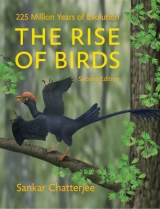
The Rise of Birds
225 Million Years of Evolution
Seiten
1997
Johns Hopkins University Press (Verlag)
978-0-8018-5615-0 (ISBN)
Johns Hopkins University Press (Verlag)
978-0-8018-5615-0 (ISBN)
- Titel erscheint in neuer Auflage
- Artikel merken
Zu diesem Artikel existiert eine Nachauflage
Birds are often regarded as "living dinosaurs" - successful vertebrates which have evolved, adapted and survived over a period of 225 million years. This volume is a detailed review of the fossil record of birds in a modern phylogenetic context, with a chronology since Protoavis.
Dinosaurs have become so popular that their flying relatives are often neglected, even though they are still among us. Birds, the "living dinosaurs", are successful vertebrates which have evolved, adapted and survived over a period of 225 million years. This text is a detailed, illustrated review of the fossil record of birds in a modern context. Palaeontologist, Chatterjee, provides a chronology documenting the long odyssey of birds since Protoavis - which may have taken to the air some 75 million years before the widely known "first bird", Archaeopterix. Throughout the text, the author offers details from the history of birds past and present, including: some intelligent theropods such as dromaeosaurs were arboreal and could climb trees with their swivel wrist joint and stiff tail, and glide from tree to ground; the discovery of downy theropod dinosaurs from China indicates that upper jaw mobility, not feathers, is the most distinctive characteristic of birds; and most birds were wiped out 65 million years ago, along with dinosaurs, by large meteoritic impacts. However, a few lineages of birds rebounded from this catastrophe and underwent an explosive evolution.
The volume also discussed the significance of the many recently discovered bird and possible bird fossils, from Europe to China to Latin America. Chatterjee outlines varying theories of how animal flight developed and explains, in terms of comparative anatomy, what makes a bird a bird. The book covers some of the greatest events in avian development: their emergence in the Triassic pangean world; their flight refinement and global diversification during the continental breakup of the Jurassic and Cretaceous periods; their sudden decline at the end-Cretaceous extinction; their rebound and explosive radiation during the Cenozoic era; and finally their destiny with us.
Dinosaurs have become so popular that their flying relatives are often neglected, even though they are still among us. Birds, the "living dinosaurs", are successful vertebrates which have evolved, adapted and survived over a period of 225 million years. This text is a detailed, illustrated review of the fossil record of birds in a modern context. Palaeontologist, Chatterjee, provides a chronology documenting the long odyssey of birds since Protoavis - which may have taken to the air some 75 million years before the widely known "first bird", Archaeopterix. Throughout the text, the author offers details from the history of birds past and present, including: some intelligent theropods such as dromaeosaurs were arboreal and could climb trees with their swivel wrist joint and stiff tail, and glide from tree to ground; the discovery of downy theropod dinosaurs from China indicates that upper jaw mobility, not feathers, is the most distinctive characteristic of birds; and most birds were wiped out 65 million years ago, along with dinosaurs, by large meteoritic impacts. However, a few lineages of birds rebounded from this catastrophe and underwent an explosive evolution.
The volume also discussed the significance of the many recently discovered bird and possible bird fossils, from Europe to China to Latin America. Chatterjee outlines varying theories of how animal flight developed and explains, in terms of comparative anatomy, what makes a bird a bird. The book covers some of the greatest events in avian development: their emergence in the Triassic pangean world; their flight refinement and global diversification during the continental breakup of the Jurassic and Cretaceous periods; their sudden decline at the end-Cretaceous extinction; their rebound and explosive radiation during the Cenozoic era; and finally their destiny with us.
Sankar Chatterjee is Paul Whitfield Horn Professor of geology and curator of paleontology at Texas Tech University. He led expeditions to India, China, Antarctica, and the American Southwest in search of the dinosaurs and their contemporaries.
| Erscheint lt. Verlag | 4.11.1997 |
|---|---|
| Vorwort | Lawrence M. Witmer |
| Zusatzinfo | 92 illustrations |
| Verlagsort | Baltimore, MD |
| Sprache | englisch |
| Maße | 216 x 279 mm |
| Gewicht | 1115 g |
| Themenwelt | Schulbuch / Wörterbuch ► Lexikon / Chroniken |
| Naturwissenschaften ► Biologie ► Zoologie | |
| Naturwissenschaften ► Geowissenschaften ► Mineralogie / Paläontologie | |
| ISBN-10 | 0-8018-5615-9 / 0801856159 |
| ISBN-13 | 978-0-8018-5615-0 / 9780801856150 |
| Zustand | Neuware |
| Haben Sie eine Frage zum Produkt? |
Mehr entdecken
aus dem Bereich
aus dem Bereich



